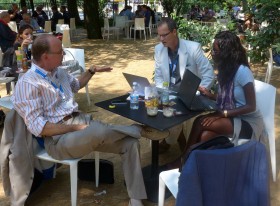Ethical Challenges and Religious Diversity
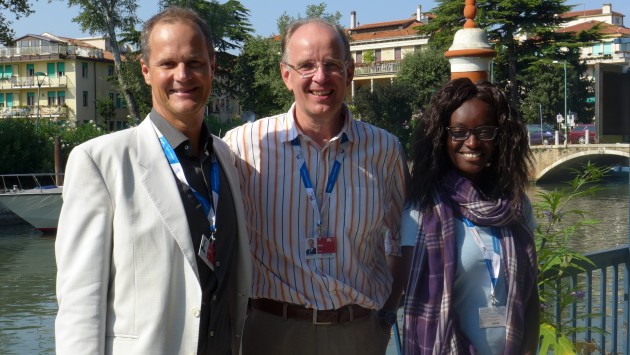
The jury members, from left: Tomas Axelsson, Ralf Meister, Anita Nipah
Being a part of the INTERFILM Jury in Venice means to spend ten days extensively exposed to important films. This year 2014, the Venice film festival received 1700 applicant films from all over the world. Out of these the organizers selected altogether 55 films to be screened in the cinemas during the festival. We who were privileged to be part of the jury, Ralf Meister, Germany, Anita Nipah, Italy and myself from Sweden, watched altogether 29 films from the two competition sections, Venezia 71 and Orizzonti, in general three 2 hour films a day. The jury experience is unique. You get to see stories from all corners of the world and the stories are for the most part urgent, well told and with a striking passion to reach out to the audience in new ways. As a jury member you also get to know cultural circumstances from far away as well as societal realities often shielded and kept out of sight from the visible surface of modern life.
My impression from watching all these troublesome movies from the Saudi Arabia, China, Croatia, France, India, Indonesia, Iran, Italy, Mexico, Japan, Sweden, Russia and US is that the world is heavily burdened with human experience of confusion, turmoil and suffering. And I think that this is not only a result of the directors’ and scriptwriters’ wish to indulge in human pain for its own sake. I believe the stories told are accurate for a description of how many people suffer in todays’ contemporary life, as a moment in time, rooted in troublesome history.
Overwhelmed by these impressions we also had a specific task, being members of the INTERFILM Jury. Our mission was to look for a film which in its epic construction of a story could be viewed as promoting interreligious dialogue in our world. And we did.
Film implicitly promoting interreligious dialogue – Loin des hommes (2014)
After the screening of the film Loin des hommes (Far From Men, 2014) by French director David Oelhoffen we identified a theme which could be of interest for us in the jury, since it tells a parable of human relationship overcoming hostility and in that sense fitted well into the criteria of the Interfilm Award. We discussed to which degree the French teacher and the Algerian detainee were representatives of their respective religious traditions, Christianity and Islam. It was obvious they had different cultural background since in the film the two men talked French and Arabic alternatively with each other developing their friendship across cultural barriers. The film underlined the theme of respect through their use of each other’s tongue in critical situations deepening their capacity to reach out to the other.
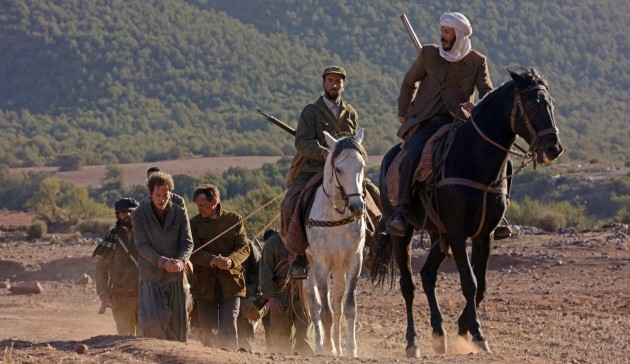
We acknowledged the ethical dimension that the director displayed in the film. The explicit cultural difference also included a religious one, even if it was shown only rarely on the screen in the actions of the two men. Important for our discussion was the fact that the two individuals took a stand against their own cultural group, questioning corrupted cultural norms, prejudices and hatred emanating from their own cultural world view. Consequently we understood the film as carrying an important ethical dimension; a call to approve the unique value of your fellow human being, equality across cultural boundaries and acknowledging the other as your neighbour, all set in a striking desert landscape illuminating the ethical choices with an absolute clarity.
Film explicitly promoting interreligious dialogue – Words With Gods (2014)
Another important impression in Venice 2014 was the launching of the film project Words With Gods (2014). The Mexican director Guillermo Arriaga has managed to gather 9 renowned directors around the world, contributing to a collage, consisting of nine distinct short stories in which the phenomenon of religion is portrayed in intriguing ways. The film project is aimed to go beyond a plain movie experience and its ambition is to cooperate with institutions, organizations and universities around the world who work with inter-faith dialogue and reconciliation in the multicultural modern world. The jury was impressed and touched by several of the nine short films and hopes that the project will be able to address this topic in coming years through this film significantly. The jury therefore highlighted the film Words With Gods (2014) explicitly at the award ceremony for showing the complex diversity of religious beliefs in different cultures and social environments.
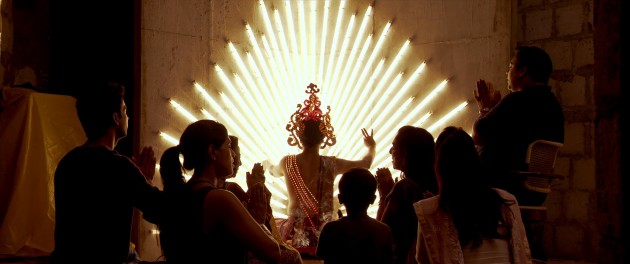
The power and the strength, the ambivalence and the danger, the consolation and hope of religion are put in 9 different short stories directed by significant directors. This film is even more as a personal statement or religious information about living faith; it is also a project for working on religious dialogue and tolerance.
Finally a word on the Golden Lion winner in Venice 2014 which happened to be the Swedish contribution in the festival official competition selection.
The Winner of the Golden Lion Venice 2014: The Pigeon Sat on a Branch Reflecting on Existence (2014), by director Roy Anderson, Sweden
The film screening at Sala Grande with its more than thousand seats was very interesting in an unusual way. The film managed to cheer the audience with its uniquely absurd humor and its non-narrative tableau format with deep focus, creating impressionistic as well as narrative dimensions, open for the audience to interpret its long and slowly takes. Even if the film had a bleak and dystopic look, many viewers reacted with laughter during the screening, even giving single scenes a hand, applauding the cinematographic accomplishment. Similar to how a jazz audience reacts to a skilled jazz musician giving an impressive solo in the middle of a tune, the Sala Grande audience gave some of the scenes in the middle of the film, extra-ordinary appreciation, laughing and applauding. This interaction with the screen was something surprising for me and I have only experienced it once before, in 1977, when the crowd watching the final triumph of Luke Skywalkers successful deathblow and exploded in cheers and applauds when he took the shot that managed to extinguish the lethal threat of the death star in Star Wars (1977).
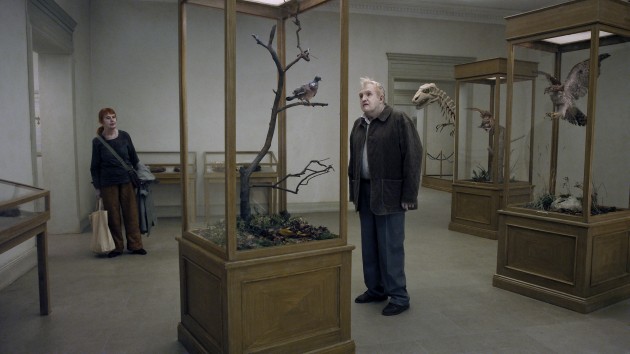
In the jury we did not ponder this Swedish warm hearted and politically subversive film as relevant to our criteria and left it aside in our discussion. But the reception of the audience at the screening gave a hint about how well it left off in Venice. Considering its unorthodox filmic style it was also a compelling choice, giving praise to the unique artistic skills of the Swedish film director Roy Anderson, and his exploration of visual poetry as an important dimension of the art of filmmaking as well as his creation of non-narrative story-telling.

